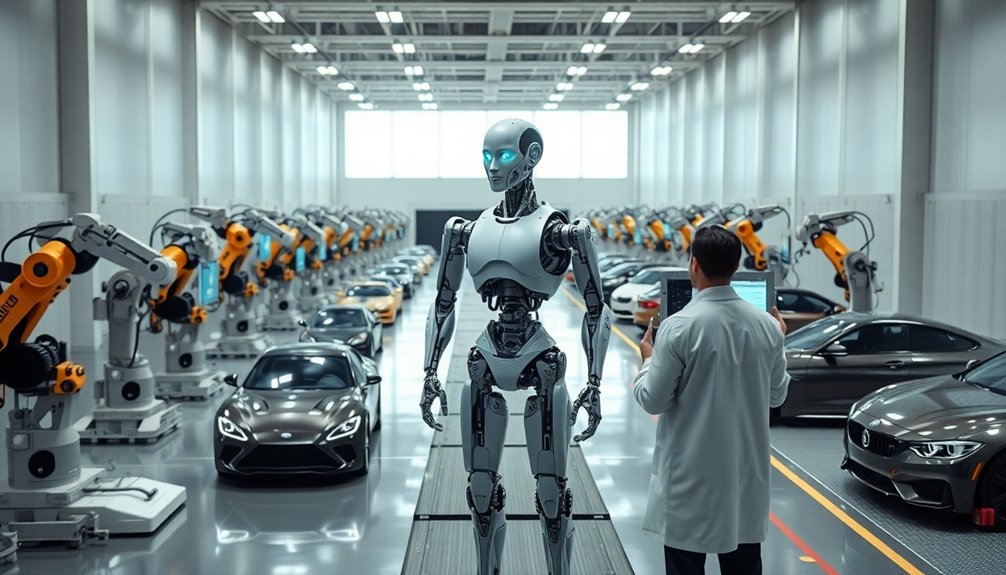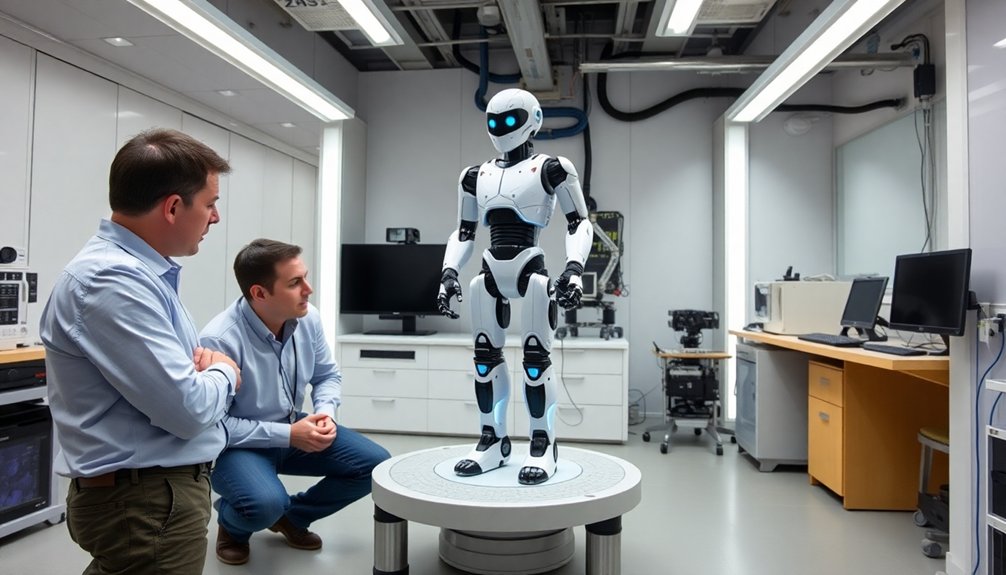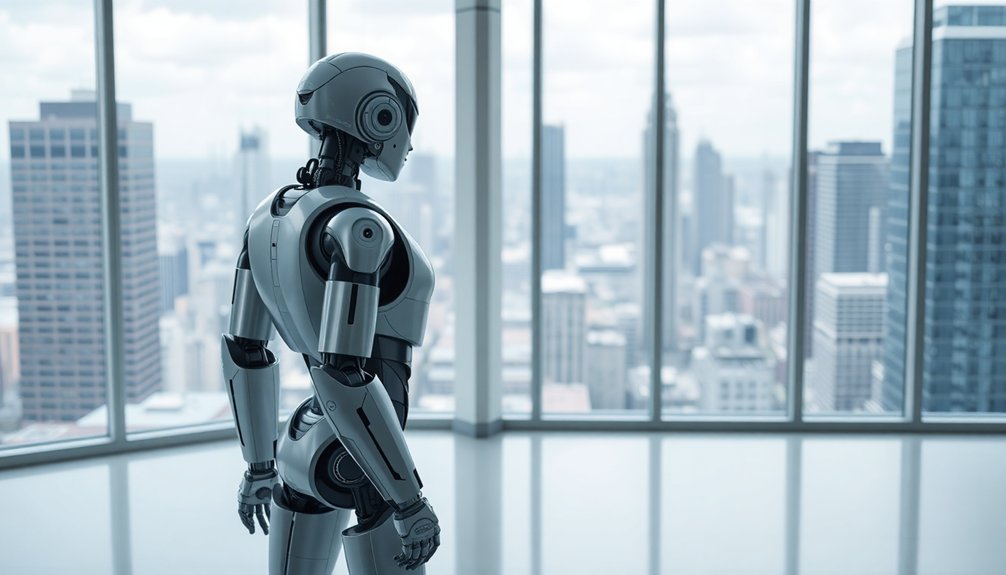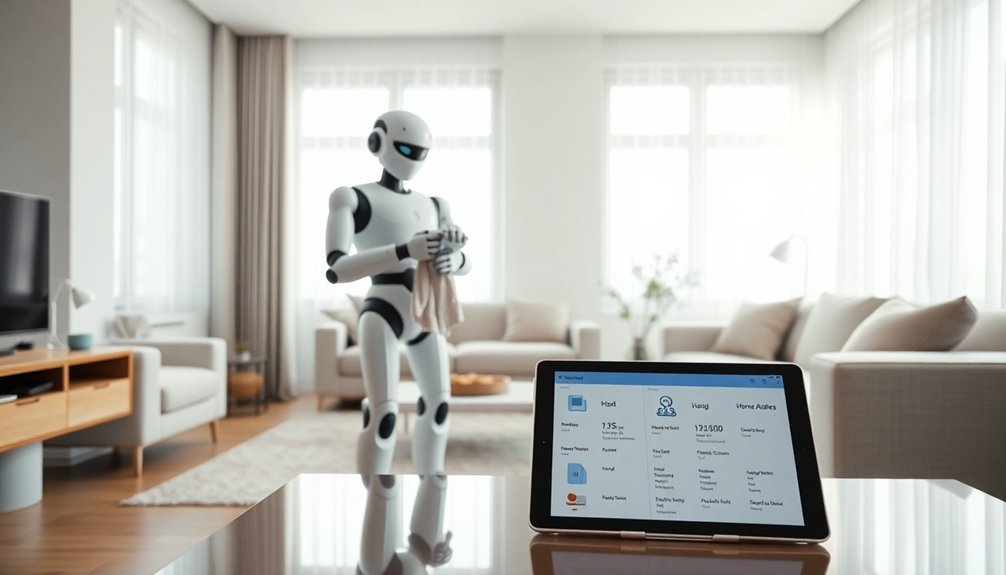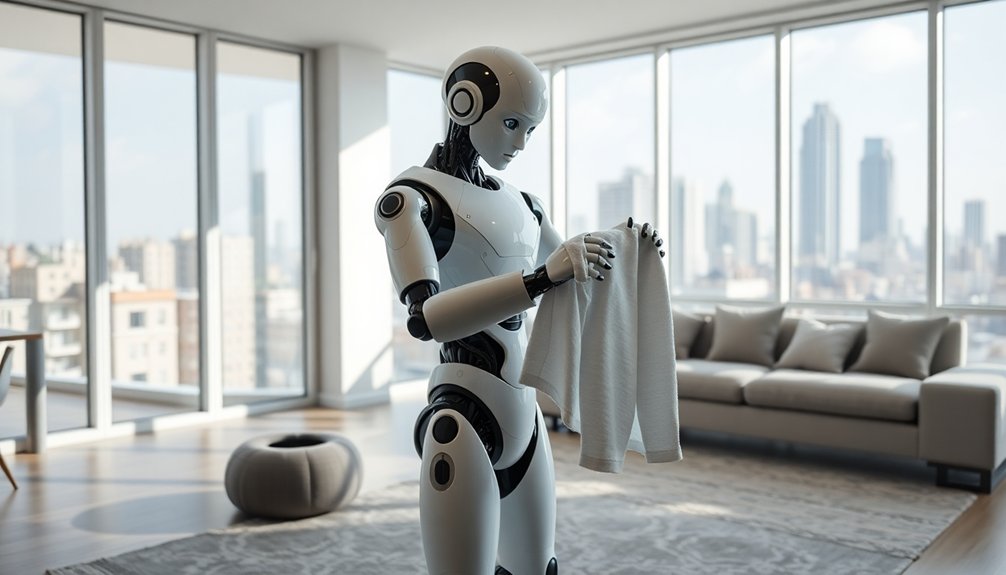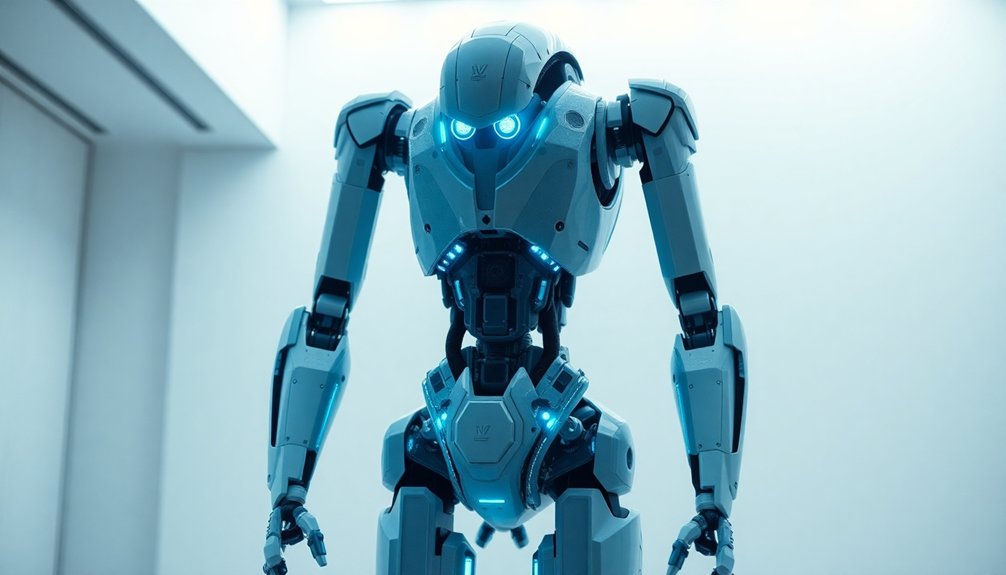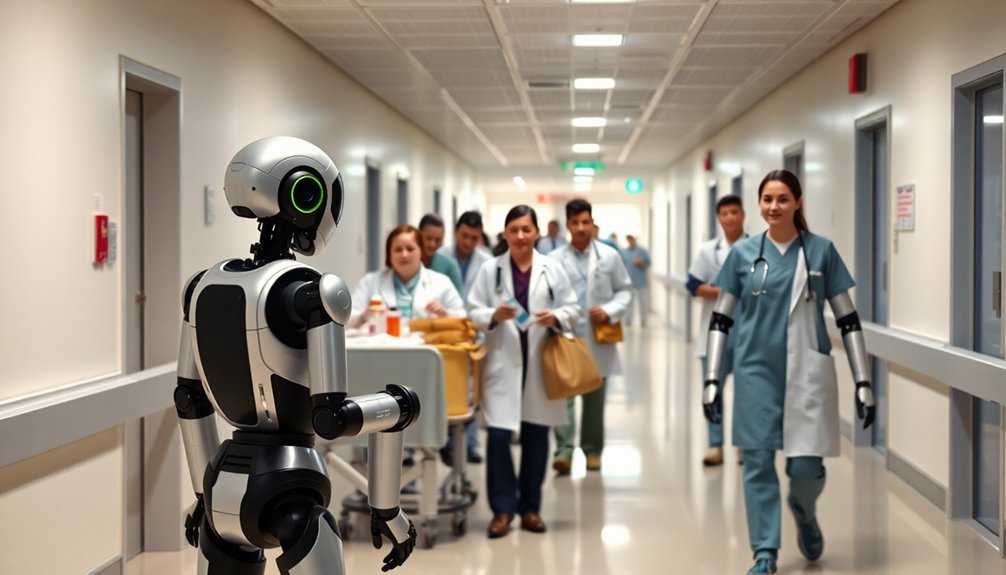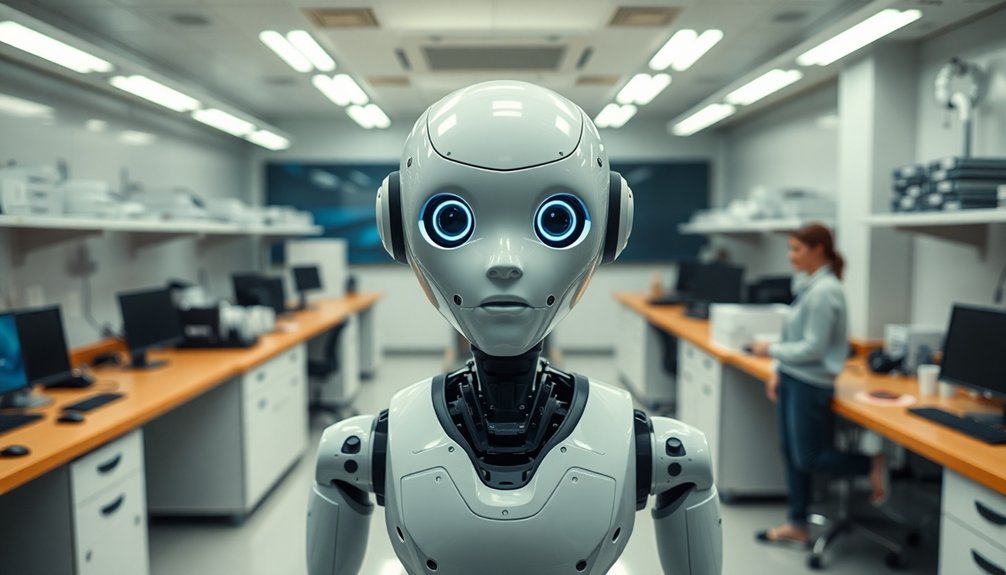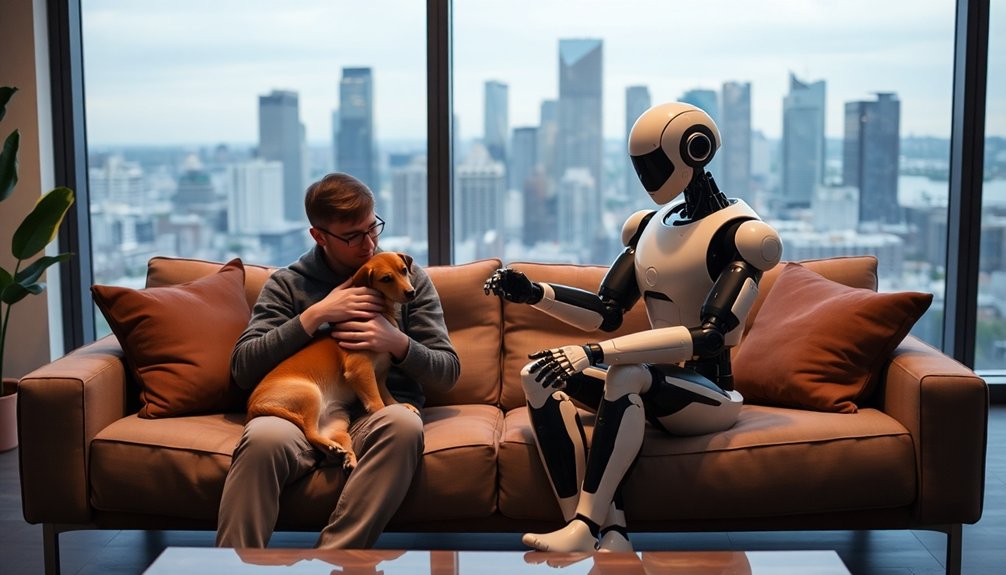Humanoid robots aren’t cookie-cutter clones—they’re technological snowflakes shaped by function, culture, and design philosophy. We craft each robot like a unique sculpture, balancing biomimetic engineering with specific purpose. Want a search-and-rescue bot? Expect rugged, utilitarian design. Aiming for social interaction? Prepare for smoother, more nuanced forms. Cultural influences, technological constraints, and intended use create robotic diversity. Curious about the secret sauce? Stick around.
The Bionic Blueprint: Mimicking Human Form and Function
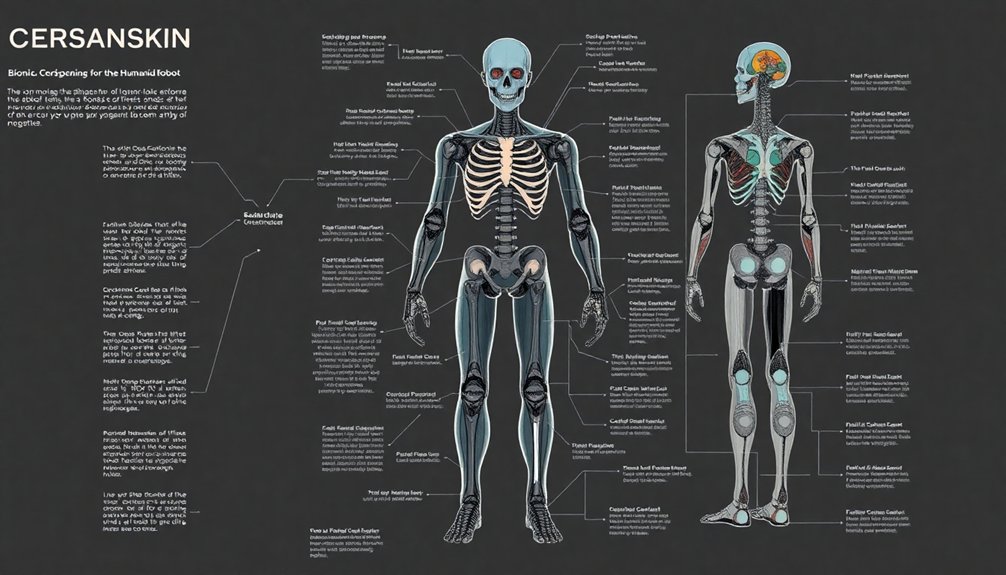
When we talk about humanoid robots, we’re not just designing machines—we’re reimagining what it means to be human. Our bionic principles transform cold metal and circuits into something almost alive. Sensory device innovations enable robots to perceive and interact with their environment in increasingly sophisticated ways. Multi-spectral imaging technologies allow robots to see far beyond human visual capabilities, capturing depth and contextual information with unprecedented precision.
We’re obsessed with human adaptation, using ergonomic innovation to create robots that move like us, think like us, and sometimes—let’s be honest—might even look better than us. Mechanical efficiency meets design aesthetics in biomimetic structures that challenge our understanding of functionality.
Each robot becomes a canvas where engineering meets art, where functional diversity transforms rigid technology into something fluid and dynamic. And here’s the real magic: these designs aren’t just about performance. They’re about creating an emotional connection, bridging the gap between human imagination and technological possibility.
Lightweight Engineering: Balancing Performance and Mechanical Efficiency
From mimicking human form to engineering lightweight robotic marvels, we’re now zooming in on the secret sauce of next-gen humanoid design. Joint performance and muscle arrangement directly influence the robot’s movement efficiency and biomechanical precision. Parallel-kinematics leg design allows engineers to explore more advanced mobility configurations beyond traditional robotic architectures. Servo motor technology enables precise biomechanical adaptations that transform rigid mechanical structures into fluid, responsive systems.
Performance optimization isn’t just about making robots stronger—it’s about making them smarter and leaner. We strategically select materials like carbon fiber and aluminum to slash weight without sacrificing strength.
Smart engineering transcends raw power—it’s about intelligent design and strategic material selection that amplifies robotic potential.
Our design philosophy? Create robots that move efficiently by distributing weight intelligently and developing computational systems that predict and adapt to motion patterns.
Energy efficiency becomes our north star, driving decisions about robust actuation and scalable design. By embracing sustainable practices and focusing on cost-effective engineering, we’re not just building machines—we’re crafting the future of human-robot interaction, one lightweight component at a time.
Sensing the World: Environmental Adaptation and Obstacle Navigation
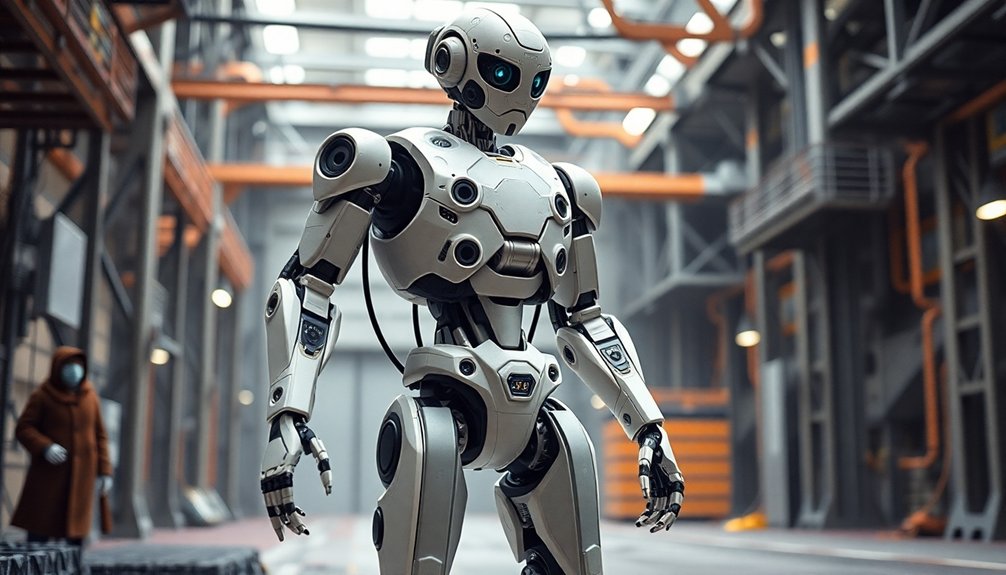
We’re building robots that can sense their world like sci-fi protagonists traversing an alien landscape, turning complex sensor arrays into a symphony of environmental understanding. Specifically, humanoid robots utilize force and torque sensors to precisely measure and interpret mechanical interactions, enabling adaptive movement and responsive navigation. Our sensory systems transform mechanical beings from blind wanderers into intelligent explorers, combining technologies like LiDAR, vision systems, and machine learning to help robots read their surroundings with near-human intuition. Intelligent sensor fusion allows robots to integrate data from multiple sources, creating a comprehensive understanding of their environment that goes beyond simple perception. Environmental monitoring robots leverage advanced sensor technologies to collect critical data about ecosystem parameters, expanding their sensing capabilities beyond simple navigation to comprehensive environmental assessment.
Robotic Sensory System Design
Because robots need to understand their world like we do, sensory systems represent the eyes, ears, and skin of humanoid machines. Environmental sensing complexity requires sophisticated neural network architectures that mimic biological information processing. Sensor modality adaptation allows robotic systems to dynamically reconfigure their perceptual strategies based on environmental challenges.
We’re talking about sensor sensitivity that catches the tiniest environmental whispers, with multi-modal perception systems enabling robots to integrate vision, touch, and motion data simultaneously.
Adaptive algorithms and real-time processing mean these machines can map their surroundings faster than you can blink.
Data fusion combines inputs from LiDAR, cameras, and tactile sensors, creating a thorough environmental snapshot.
Sensory redundancy makes certain they won’t miss a beat, even if one sensor goes wonky.
And let’s be real: actuator efficiency means these mechanical marvels move with precision that would make a ballet dancer jealous.
Who said robots can’t be smart and smooth?
Navigate Complex Environments
Sensing and surviving aren’t just human skills anymore—robots are mastering the art of environmental ninja-like adaptation.
We’ve cracked the code on terrain adaptability by designing robots that morph like liquid metal mercenaries. Think soft robotics that squeeze through tight spaces, intelligent mobility systems that dance across rugged landscapes, and autonomous navigation that reads environmental cues faster than you check your smartphone. Real-time perception enables robots to continuously update their understanding of the surrounding environment, dynamically adjusting their approach to complex tasks. Advanced sensor integration allows robots to collect and process complex environmental data with unprecedented precision. LiDAR and radar technologies provide robots with an advanced 3D mapping capability that enables intricate environmental navigation.
Environmental robustness isn’t just a buzzword—it’s survival. Our robots pack sensors that monitor everything from temperature to terrain stress, while predictive algorithms anticipate potential failures before they happen.
We’re talking about machines that don’t just survive harsh conditions; they thrive in them. Corrosive chemicals? Extreme temperatures? Unstable ground? Bring it on.
Social Intelligence: Programming Interaction and Behavioral Codes
We’re teaching robots to read the room like a seasoned diplomat, training them to pick up on subtle social cues that most humans barely notice themselves. Drawing from Internet of Robotic Things, robots are increasingly designed to establish seamless connectivity and adaptive communication channels with human environments.
Our goal isn’t just mimicking human behavior, but creating machines that can intuitively understand context, recognize unspoken tensions, and respond with remarkable social grace.
Imagine a robot that can tell when you’re stressed, frustrated, or need a moment of quiet empathy – that’s the next frontier of social intelligence we’re building.
Sensing Social Cues
When it comes to humanoid robots playing nice with humans, understanding social cues isn’t just a fancy tech trick—it’s survival. We’re talking about gaze interpretation and social cue detection that make robots feel less like cold machines and more like intelligent companions.
| Sensor Type | Detection Skill | Social Impact |
|---|---|---|
| Visual | Facial Expressions | Emotional Rapport |
| Audio | Voice Tone | Communication Flow |
| Kinetic | Movement Patterns | Interaction Smoothness |
Our robots need to read humans like a social playbook—catching subtle shifts in posture, tracking eye movements, and responding with near-human precision. It’s not just about algorithms; it’s about creating empathetic interactions that bridge the human-machine divide. Can we teach robots to be socially savvy? The future says: absolutely.
Learning Behavioral Norms
The social blueprint of humanoid robots isn’t just coded—it’s choreographed. We’re not just programming machines; we’re teaching them to dance through complex social landscapes.
Our approach to behavioral norms involves:
- Capturing nuanced interaction dynamics through continuous learning algorithms
- Translating human social expectations into precise robotic responses
- Building adaptive feedback systems that evolve with each interaction
- Integrating contextual understanding beyond simple rule-following
Imagine a robot that doesn’t just follow instructions, but understands the unspoken choreography of human communication.
It’s like training a highly intelligent apprentice who learns not just what to do, but how to do it with grace, subtlety, and an increasing sense of social finesse.
We’re fundamentally creating social intelligence from lines of code—one interaction at a time.
Adaptive Interaction Protocols
Mapping social intelligence onto robotic systems isn’t just programming—it’s psychological architecture. We’re designing robots that adapt faster than a chameleon changes colors, creating interaction flexibility through smart adaptive strategies. But how do we teach machines to read human nuance?
| Interaction Level | Robot Response | Human Perception |
|---|---|---|
| Low Complexity | Basic Feedback | Neutral |
| Medium Complexity | Contextual Cues | Engaged |
| High Complexity | Dynamic Adjust | Collaborative |
Our approach transforms robots from rigid machines into responsive partners. We’re programming emotional intelligence that learns, adjusts, and anticipates human needs. By integrating affective signal processing and behavioral adaptation, these machines become more than tools—they’re collaborative companions. Imagine a robot that understands your mood, adjusts its communication style, and supports you seamlessly. That’s not science fiction; that’s our current design philosophy.
Aesthetic Challenges: Navigating the Uncanny Valley
Because robots are quickly becoming more human-like, designers face a bizarre psychological minefield called the uncanny valley—that creepy zone where robots look almost-but-not-quite human.
We’re exploring the delicate balance of human likeness and emotional response that makes people either embrace or recoil from robotic designs.
Here’s what makes the uncanny valley so tricky:
- Tiny imperfections in facial movements trigger deep discomfort.
- Our brains struggle to reconcile life-like appearance with unnatural behaviors.
- Social norms get violated when robots feel “almost human.”
- Trust plummets when humanoid robots miss subtle emotional cues.
It’s a scientific dance of perception: design too human, and you’re creepy; design too mechanical, and you’re cold.
The sweet spot? Just enough humanity to feel familiar, but not enough to trigger our weirdness detectors.
Mechanical Limitations: Confronting Physical Movement Constraints
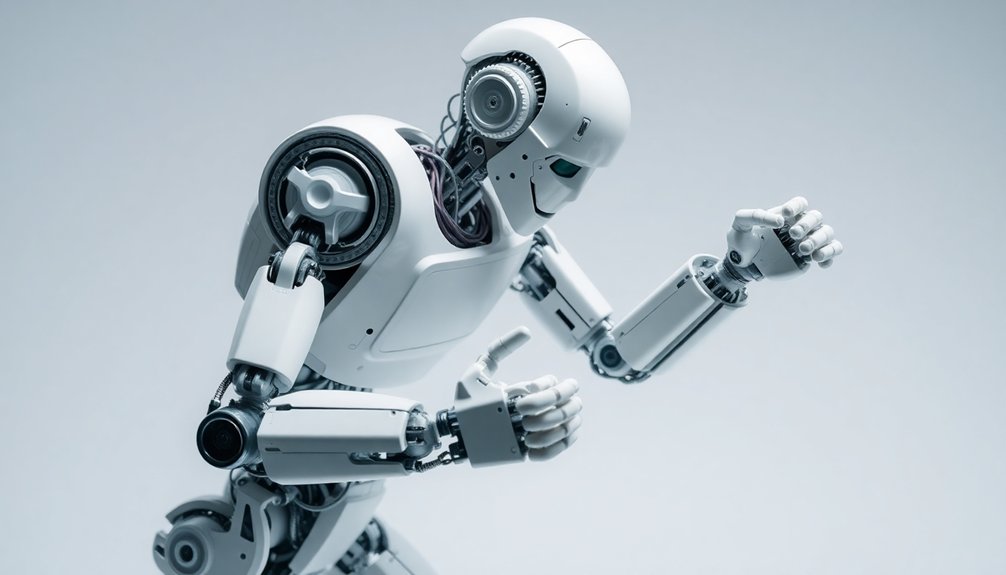
When humanoid robots dream of walking like humans, they slam into a wall of harsh mechanical realities.
Our balancing act is brutal: every step is a complex negotiation between gravity and engineering. Energy efficiency becomes our holy grail, with each movement calculating power consumption like a miserly accountant. We’re not just walking; we’re battling physics.
Bipedal movement isn’t a stroll in the park—it’s a precision dance where stability can crumble faster than a house of cards. Our robot legs might look impressive, but they’re wrestling with terrain that humans navigate effortlessly.
Stairs? Uneven ground? They’re our Mount Everest. We’re constantly redesigning, recalibrating, reimagining how to mimic that seemingly simple human trick of putting one foot in front of the other without face-planting.
Design Diversity: Why No Two Humanoid Robots Look Alike
A robotic skeleton walks into a design lab—and no two look the same. Design diversity isn’t just a quirk; it’s a necessity driven by complex factors:
- Cultural Influences: Robots reflect global design perspectives, from Tokyo’s sleek minimalism to Berlin’s industrial aesthetic.
- Functional Innovation: Each robot’s form follows its unique purpose—a medical assistant looks nothing like a warehouse worker.
- Technological Constraints: Sensor arrays, computational power, and material limitations shape distinctive physical configurations.
- User Experience: We craft robots that feel approachable, relatable, and sometimes even charming to specific human audiences.
Design innovation means embracing difference.
Why should robots be cookie-cutter when humans themselves are gloriously unique? Each mechanical creation tells a story—of its creators, its purpose, and the evolving relationship between humans and technology.
People Also Ask
Why Do Humanoid Robots Struggle With Climbing Stairs?
We struggle with stair navigation because our balance mechanisms can’t instantly adapt to uneven surfaces, requiring complex sensory integration and real-time movement calculations that challenge our mechanical design.
How Expensive Are Advanced Humanoid Robot Prototypes?
We’ve found advanced humanoid robot prototypes range from $20,000 to $130,000, with robot development costs and prototype manufacturing expenses varying based on technological complexity, AI integration, and industrial application requirements.
Can Humanoid Robots Develop Genuine Emotional Understanding?
We’re exploring emotional intelligence, yet current robots can’t genuinely understand emotions. They simulate empathy through algorithmic responses, falling short of genuine emotional comprehension despite advanced perception capabilities.
What Prevents Humanoid Robots From Looking Exactly Human?
We can’t replicate human appearance exactly due to design constraints in robot aesthetics, including mechanical complexity, material limitations, and technological challenges that prevent precise human duplication.
Do Different Robot Manufacturers Share Design Philosophies?
While specialization drives divergence, manufacturers share core design philosophies. We prioritize modular approaches, AI integration, and brand identity, creating unique robots that balance design variations with collaborative technological principles.
The Bottom Line
As we navigate the wild frontier of robotics, we’ve learned that beauty’s more than skin deep. Every robot’s a unique puzzle, shaped by its purpose and potential. Like snowflakes, no two humanoids are identical—and that’s the point. We’re not just building machines; we’re crafting digital companions that reflect our ever-evolving understanding of intelligence and design. Innovation, after all, loves diversity.
References
- https://www.servomagazine.com/magazine/article/humanoid-robotics-design-considerations
- https://www.brookings.edu/articles/the-5-principles-of-robot-design-for-optimal-human-response/
- https://www.designprinciplesftw.com/collections/7-principles-of-efficient-human-robot-interaction
- https://www.science.org/doi/10.1126/scirobotics.aaq0899
- https://animatronicrobotics.com/blog/important-addition-humanoid-robot-design/
- https://www.atlantis-press.com/article/21450.pdf
- https://future-tech-robotics-automation.peersalleyconferences.com/tracks/bionics-and-humanoid-robots
- https://aisel.aisnet.org/cgi/viewcontent.cgi?article=1632&context=hicss-57
- https://www.xiaorgeek.net/blogs/news/design-principles-and-practical-application-scenarios-of-bionic-hexapod-intelligent-robot
- https://www.wevolver.com/article/design-considerations-for-humanoid-robots



